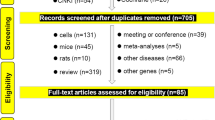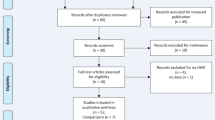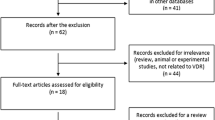Abstract
The aim of this study was to explore whether vitamin D receptor (VDR) polymorphisms confer susceptibility to psoriasis. Meta-analyses were conducted on the associations between the VDR ApaI, TaqI, BsmI, and FokI polymorphisms and psoriasis. Nine relevant studies on VDR polymorphisms and psoriasis were included in this meta-analysis, which involved 742 psoriasis patients and 715 controls. Meta-analysis indicated an association between the VDR ApaI A allele and psoriasis in Turkish studies (OR = 0.684, 95% CI = 0.475–0.985, p = 0.041). Meta-analysis indicated an association between the BsmI B allele and psoriasis in Asians (OR = 0.636, 95% CI = 0.411–0.984, p = 0.041), and showed a significant association between the FF and ff genotypes of the FokI polymorphism and psoriasis in all study subjects and in Turkish studies (OR = 2.028, 95% CI = 1.194–3.446, p = 0.009; OR = 3.582, 95% CI = 1.602–8.009, p = 0.002). This meta-analysis suggests that the VDR ApaI polymorphism confers susceptibility to psoriasis in the Turkish population. In addition, associations were found between the BsmI polymorphism and susceptibility to psoriasis in Asians and between the Fok I polymorphism and psoriasis in the Turkish population.
Similar content being viewed by others
Avoid common mistakes on your manuscript.
Introduction
Psoriasis is a chronic inflammatory skin disorder characterized by keratinocyte hyperproliferation and increased blood flow induced by the stimulation of tissue-resident immune cells by markedly altered cutaneous cytokine profiles [1, 2]. Psoriasis is the most common autoimmune disorder and affects 0.5–3% of the general population. Although its etiology is not fully understood, it has been established that psoriasis has a genetic component, and to date, human leukocyte antigen (HLA) loci are the most powerful genetic factors identified [3]. However, increasing evidence suggests that non-HLA genes also contribute [4].
Although the primary function of vitamin D is the regulation of bone mineral homeostasis, it is also involved in interleukin (IL)-2 inhibition, antibody production, and lymphocyte proliferation, and thus, vitamin D is considered to be a regulator of the immune system [5]. It is known that 1,25-dihydroxy vitamin D3 (1,25(OH)2 D3) inhibits interferon secretion and negatively regulates IL-12 production by downregulating nuclear factor-kappaB [6]. Furthermore, in one in vitro study, 1,25(OH)2 D3 was found to have a preventative effect on autoimmune diseases [7].
The action of vitamin D is dependent on vitamin D receptor (VDR), a member of the nuclear hormone receptor superfamily, and the VDR gene is one of the most frequently studied genes in the context of psoriasis. This gene is located on chromosome 12q13.11 [8], and three polymorphisms, BsmI, ApaI (both in intron 8), and TaqI (in exon 9), have been identified at the 3′-end of the gene, and shown to be in strong linkage disequilibrium (LD) [9]. The other polymorphic region, FokI, is located in the start codon. Although the functional significances of these four VDR polymorphisms remains unknown, it is believed that LD and one or more functional polymorphisms elsewhere in the VDR gene explains observed associations between the polymorphisms of the VDR gene and autoimmune diseases. These VDR polymorphisms have been associated with several autoimmune diseases in some reports, but by no means in all [10, 11]. The reasons for this disparity may be small sample sizes, low statistical power, and/or clinical heterogeneity. Therefore, in order to overcome the limitations of individual studies, resolve inconsistencies, and reduce the likelihood that random errors are responsible for false-positive or false-negative associations, we turned to meta-analysis. The aim of the present study was to determine using meta-analysis whether the VDR ApaI, TaqI, BsmI, and TaqI polymorphisms confer susceptibility to psoriasis.
Methods
Identification of eligible studies and data extraction
We performed a search of studies that examined associations between VDR polymorphisms and psoriasis. The literature was searched using the MEDLINE citation database to identify available articles in which VDR polymorphisms were analyzed in psoriasis patients. Combinations of keywords, such as, ‘vitamin D,’ ‘VDR,’ ‘polymorphism,’ and ‘psoriasis’ were entered as Medical Subject Headings (MeSH) or text words. References in identified studies were also investigated to identify additional studies not indexed by MEDLINE. Genetic association studies that determine the distributions of ApaI, TaqI, BsmI, and FokI genotypes in psoriasis and normal controls were also eligible for inclusion. The following information was extracted from each study: author, year of publication, ethnicity of the study population, demographics, and numbers of cases and controls for each of the ApaI, TaqI, BsmI, and FokI genotypes. Frequencies of alleles were calculated from corresponding genotype distributions.
Evaluation of publication bias
Funnel plots are often used to detect publication bias. However, due to the limitations of funnel plotting, which requires a range of studies of varying sizes involving subjective judgments, we evaluated publication bias using Egger’s linear regression test [12], which measures funnel plot asymmetry using a natural logarithm scale of odds ratios (ORs).
Evaluations of statistical associations
We performed meta-analyses using; (1) allelic contrast, (2) contrast of homozygotes, (3) recessive, and (4) dominant models. Point estimates of risk, ORs, and 95% confidence intervals (CI) were estimated for each study. In addition, within- and between-study variations or heterogeneities were assessed using Cochran’s Q-statistic. This heterogeneity test assesses the null hypothesis that all studies evaluated the same effect. The effect of heterogeneity was quantified using I2, which ranges between 0 and 100%, and represents the proportion of between-study variability that can be attributed to heterogeneity rather than chance [13]. I2 values of 25, 50, and 75% were nominally assigned as low, moderate, and high estimates. The fixed effects model assumes that genetic factors have similar effects on psoriasis susceptibility across all studies investigated, and that observed variations among studies are caused by chance alone [14]. The random effects model assumes that different studies show substantial diversity and assesses both within-study sampling error and between-study variance [15]. When study groups are homogeneous, the fixed and random effects models are similar, and when this is not the case the random effects model usually provides wider CIs than the fixed effects model. The random effects model is used in the presence of significant between study heterogeneity [15]. Statistical manipulations were undertaken using a Comprehensive Meta-Analysis computer program (Biosta, Englewood, NJ, USA).
Results
Studies included in the meta-analysis
Nine relevant studies on VDR polymorphisms in psoriasis met the study inclusion criteria, and in total, these studies involved 742 psoriasis patients and 715 controls [16–24], and consisted of 4 Asian, 2 European, and 2 Turkish studies, and 1 Arab population study (Table 1).
Six studies examined the VDR ApaI polymorphism, 6 the VDR TaqI polymorphism, 5 the BsmI polymorphism and 4 the VDR FokI polymorphism. Selected characteristics of these studies with respect to associations between VDR polymorphisms and psoriasis are summarized in Table 1. Meta-analysis was performed on the association between polymorphisms and psoriasis when there were at least 2 relevant studies. In addition, ethnicity-specific meta-analysis was performed in Asian and Turkish populations.
Heterogeneity and publication bias
No between-study heterogeneity was found during the meta-analyses of the VDR BsmI and FokI polymorphisms, but some heterogeneity was found in the meta-analyses of the ApaI and TaqI polymorphisms for all studies. It was difficult to correlate the funnel plot, which is usually used to detect publication bias, because the number of studies included in the analysis was relatively small. However, Egger’s regression test showed no evidence of publication bias (Egger’s regression test p values >0.1).
Meta-analysis of relations between the VDR ApaI, TaqI, BsmI, and FokI polymorphisms and psoriasis
A summary of meta-analyses findings regarding the association between the VDR polymorphisms and psoriasis is provided in Table 2. Meta-analysis of the VDR ApaI polymorphism showed no association between psoriasis and the VDR ApaI A allele in all study subjects (psoriasis patients plus normal controls; OR = 0.940, 95% CI = 0.616–1.435, p = 0.775) (Table 2; Fig. 1). However, stratification by ethnicity revealed a significant association between the VDR ApaI A allele and psoriasis in the Turkish populations (OR = 0.684, 95% CI = 0.475–0.985, p = 0.041) (Table 2, Fig. 2). Furthermore, an association was found between psoriasis and VDR ApaI polymorphism using the recessive model (OR = 0.516, 95% CI = 0.294–0.903, p = 0.021). However, no association was found between the TaqI polymorphism and psoriasis using the allele contrast, recessive, or dominant models, or according to contrast of homozygotes in Asian or Turkish populations or in all study subjects (Table 2).
Furthermore, meta-analysis showed no association between psoriasis and the BsmI B allele in all study subjects (Table 3, Fig. 1). However, stratification by ethnicity indicated a significant association between the VDR BsmI allele and psoriasis in Asians (OR = 0.636, 95% CI = 0.411–0.984, p = 0.041) (Table 3, Fig. 2). Meta-analysis of the F allele, FF genotype, and FF + ff genotype of the FokI polymorphism showed no association with psoriasis (Table 3), but meta-analysis of the FF and ff genotypes showed a significant association with psoriasis in all study subjects and in the Turkish populations (OR = 2.028, 95% CI = 1.194–3.446, p = 0.009; OR = 3.582, 95% CI = 1.602–8.009, p = 0.002) (Table 3, Fig. 2).
Discussion
Although association studies are excellent at identifying genetic factors that confer susceptibility to common diseases like psoriasis, most reported association studies are underpowered in terms of detecting modest genetic effects that underlie susceptibilities to common diseases [25]. This underpowering results in inconsistent findings due to false-positive, false-negative, or true variabilities of associations in different populations. Meta-analysis integrates previous research and increases statistical power and resolution by pooling the results of independent analyses [26, 27], and provides a powerful means of overcoming the small sample size problem and the often inadequate statistical powers of genetic studies on complex traits.
Although the multifactorial natures of psoriasis are well recognized, genetic factors are considered to be strong determinants of these diseases, and thus, researchers have been encouraged to search for the genes responsible. Many genes have been studied in this context, and the VDR gene is one such gene in the context of psoriasis [28, 29]. Vitamin D plays a key role in calcium homeostasis and also contributes to the regulation of the immune system. Given the immunosuppressive effects of vitamin D and the potential link between vitamin D deficiency and autoimmune diseases, VDR polymorphisms, which may influence VDR activity, have been studied as potential causes of autoimmune diseases including psoriasis.
In this meta-analysis, we combined data from published studies to evaluate genetic associations between the most commonly studied polymorphisms of the VDR gene, namely, the ApaI, TaqI, BsmI, and FokI polymorphisms, and psoriasis. Our meta-analysis of the VDR TaqI polymorphism showed no association with psoriasis in all study subjects or in Asians. In contrast, meta-analysis of the ApaI and FokI polymorphisms showed significant associations with psoriasis in the Turkish populations studied. Furthermore, meta-analysis of the BsmI polymorphism revealed a significant association with psoriasis in Asians, and suggested that the A allele may be a protective factor with an OR of 0.636 (95% CI = 0.411–0.984, p = 0.042).
However, our results should be interpreted with caution because of the limited number of studies included in this meta-analysis, which also restricted further subgroup analyses. Furthermore, the relative importance of the VDR polymorphisms during the development of psoriasis may be dependent on ethnicity. However, we were unable to perform ethnicity specific meta-analysis in European psoriasis patients due to limited data.
Present study has some limitations that require consideration. First, heterogeneity and confounding factors may have distorted the analysis. Furthermore, publication bias also may have affected the analysis, because studies that produced negative results may not have been published or may have been missed, and although Egger’s regression test was used, the possibility of bias could not be eliminated. Second, ethnicity-specific analysis included data from Asian and Turkish patients, and thus, our results are applicable to only these ethnic groups. Third, haplotype analysis may have provided more information and would have been more powerful than single polymorphism analysis. Furthermore, LD was found for the BsmI, TaqI, and ApaI polymorphisms [9]. In addition, no meta-analysis of haplotypes was possible due to inadequate haplotype data. Fourth, the VDR polymorphisms may be associated with psoriasis severity, but the small amount of data available did not allow us to investigate these associations.
In conclusion, this meta-analysis demonstrates that the VDR ApaI polymorphism may confer susceptibility to psoriasis in the Turkish population. Furthermore, it shows that the BsmI polymorphism confers susceptibility to psoriasis in Asians and that the Fok I polymorphism does so in the Turkish population. These findings prompt further investigation on the associations between the VDR polymorphisms and psoriasis susceptibility. Larger scale studies in populations with different ethnicities are necessary to explore the roles of the polymorphisms of the VDR gene in the pathogeneses of psoriasis.
References
Bhalerao J, Bowcock AM (1998) The genetics of psoriasis: a complex disorder of the skin and immune system. Hum Mol Genet 7:1537–1545
Lee KH, Son MK, Ha YJ, Choi ST, Lee SW, Park YB et al (2010) Inflammatory polyarthritis in a patient with psoriasis: is it psoriatic arthritis or rheumatoid arthritis? Korean J Intern Med 25:224–226
Nair RP, Stuart PE, Nistor I, Hiremagalore R, Chia NV, Jenisch S et al (2006) Sequence and haplotype analysis supports HLA-C as the psoriasis susceptibility 1 gene. Am J Hum Genet 78:827–851
Zhang XJ, Huang W, Yang S, Sun LD, Zhang FY, Zhu QX et al (2009) Psoriasis genome-wide association study identifies susceptibility variants within LCE gene cluster at 1q21. Nat Genet 41:205–210
Maruotti N, Cantatore FP (2010) Vitamin D and the immune system. J Rheumatol 37:491–495
Boonstra A, Barrat FJ, Crain C, Heath VL, Savelkoul HF, O’Garra A (2001) 1alpha, 25-dihydroxyvitamin d3 has a direct effect on naive CD4(+) T cells to enhance the development of Th2 cells. J Immunol 167:4974–4980
Koizumi T, Nakao Y, Matsui T, Nakagawa T, Matsuda S, Komoriya K et al (1985) Effects of corticosteroid and 1,24R-dihydroxy-vitamin D3 administration on lymphoproliferation and autoimmune disease in MRL/MP-lpr/lpr mice. Int Arch Allergy Appl Immunol 77:396–404
Miyamoto K, Kesterson RA, Yamamoto H, Taketani Y, Nishiwaki E, Tatsumi S et al (1997) Structural organization of the human vitamin D receptor chromosomal gene and its promoter. Mol Endocrinol 11:1165–1179
Morrison NA, Yeoman R, Kelly PJ, Eisman JA (1992) Contribution of trans-acting factor alleles to normal physiological variability: vitamin D receptor gene polymorphism and circulating osteocalcin. Proc Natl Acad Sci USA 89:6665–6669
Uitterlinden AG, Fang Y, Van Meurs JB, Pols HA, Van Leeuwen JP (2004) Genetics and biology of vitamin D receptor polymorphisms. Gene 338:143–156
Uitterlinden AG, Fang Y, van Meurs JB, van Leeuwen H, Pols HA (2004) Vitamin D receptor gene polymorphisms in relation to Vitamin D related disease states. J Steroid Biochem Mol Biol 89–90:187–193
Egger M (1997) Davey Smith G, Schneider M, Minder C. Bias in meta-analysis detected by a simple, graphical test. BMJ 315:629–634
Higgins JP, Thompson SG (2002) Quantifying heterogeneity in a meta-analysis. Stat Med 21:1539–1558
Egger M, Smith GD, Phillips AN (1997) Meta-analysis: principles and procedures. BMJ 315:1533–1537
DerSimonian R, Laird N (1986) Meta-analysis in clinical trials. Control Clin Trials 7:177–188
Zuel-Fakkar NM, Kamel MM, Asaad MK, Mahran MZ, Shehab AA (2011) A study of ApaI and TaqI genotypes of the vitamin D receptor in Egyptian patients with psoriasis. Clin Exp Dermatol 36:355–359
Dayangac-Erden D, Karaduman A, Erdem-Yurter H (2007) Polymorphisms of vitamin D receptor gene in Turkish familial psoriasis patients. Arch Dermatol Res 299:487–491
Halsall JA, Osborne JE, Pringle JH, Hutchinson PE (2005) Vitamin D receptor gene polymorphisms, particularly the novel A-1012G promoter polymorphism, are associated with vitamin D3 responsiveness and non-familial susceptibility in psoriasis. Pharmacogenet Genomics 15:349–355
Ruggiero M, Gulisano M, Peruzzi B, Giomi B, Caproni M, Fabbri P et al (2004) Vitamin D receptor gene polymorphism is not associated with psoriasis in the Italian Caucasian population. J Dermatol Sci 35:68–70
Saeki H, Asano N, Tsunemi Y, Takekoshi T, Kishimoto M, Mitsui H et al (2002) Polymorphisms of vitamin D receptor gene in Japanese patients with psoriasis vulgaris. J Dermatol Sci 30:167–171
Kaya TI, Erdal ME, Tursen U, Camdeviren H, Gunduz O, Soylemez F et al (2002) Association between vitamin D receptor gene polymorphism and psoriasis among the Turkish population. Arch Dermatol Res 294:286–289
Okita H, Ohtsuka T, Yamakage A, Yamazaki S (2002) Polymorphism of the vitamin D(3) receptor in patients with psoriasis. Arch Dermatol Res 294:159–162
Lee DY, Park BS, Choi KH, Jeon JH, Cho KH, Song KY et al (2002) Vitamin D receptor genotypes are not associated with clinical response to calcipotriol in Korean psoriasis patients. Arch Dermatol Res 294:1–5
Park BS, Park JS, Lee DY, Youn JI, Kim IG (1999) Vitamin D receptor polymorphism is associated with psoriasis. J Invest Dermatol 112:113–116
Lohmueller KE, Pearce CL, Pike M, Lander ES, Hirschhorn JN (2003) Meta-analysis of genetic association studies supports a contribution of common variants to susceptibility to common disease. Nat Genet 33:177–182
Lee YH, Rho YH, Choi SJ, Ji JD, Song GG, Nath SK et al (2007) The PTPN22 C1858T functional polymorphism and autoimmune diseases–a meta-analysis. Rheumatology (Oxford) 46:49–56
Lee YH, Harley JB, Nath SK (2006) Meta-analysis of TNF-alpha promoter -308 A/G polymorphism and SLE susceptibility. Eur J Hum Genet 14:364–371
Crispin JC, Liossis SN, Kis-Toth K, Lieberman LA, Kyttaris VC, Juang YT et al (2010) Pathogenesis of human systemic lupus erythematosus: recent advances. Trends Mol Med 16:47–57
Raychaudhuri S (2010) Recent advances in the genetics of rheumatoid arthritis. Curr Opin Rheumatol 22:109–118
Author information
Authors and Affiliations
Corresponding author
Rights and permissions
About this article
Cite this article
Lee, Y.H., Choi, S.J., Ji, J.D. et al. Vitamin D receptor ApaI, TaqI, BsmI, and FokI polymorphisms and psoriasis susceptibility: a meta-analysis. Mol Biol Rep 39, 6471–6478 (2012). https://doi.org/10.1007/s11033-012-1466-6
Received:
Accepted:
Published:
Issue Date:
DOI: https://doi.org/10.1007/s11033-012-1466-6






